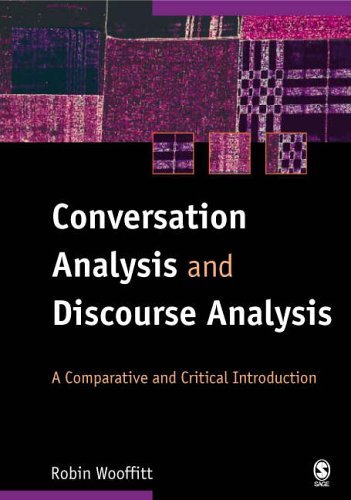Conversation Analysis and Discourse Analysis : a Comparative and Critical Introduction
Wooffitt, Robin
Sage Publications, London
2005
0761974261 (pb)
 This is both an introductory textbook and an original essay advocating a new rapprochement between Conversation Analysis (CA) and Discourse Analysis (DA). Wooffitt's position, is not so much that CA provides a "bedrock" (Wittgenstein) on which to build, but rather that conversation is the fertile soil within which social and psychological life flourishes, so study of everyday conversational practices is essential to the study of that life. Wooffitt often finds the methods of DA inferior to those of CA. But he finds the aims of DA praiseworthy, offering a valuable challenge to CA.
This is both an introductory textbook and an original essay advocating a new rapprochement between Conversation Analysis (CA) and Discourse Analysis (DA). Wooffitt's position, is not so much that CA provides a "bedrock" (Wittgenstein) on which to build, but rather that conversation is the fertile soil within which social and psychological life flourishes, so study of everyday conversational practices is essential to the study of that life. Wooffitt often finds the methods of DA inferior to those of CA. But he finds the aims of DA praiseworthy, offering a valuable challenge to CA.
For CA, a key study is Sacks, Schegloff and Jefferson's 'Simplest Systematics of Turn Taking' (1974), highlighting sequential structure. For DA, a key text is Gilbert and Mulkay's, Opening Pandora's Box (1984), studying discourse variation. The strongest branch of DA to have subsequently emerged is Discursive Psychology (DP). Classic Social Psychology saw consensus as a real resource within which strong cognitions are built. DP sees 'consensus' as a construction, used to enhance or undermine truth claims in ordinary talk.
To outsiders, CA and DA might seem trivial, preoccupied with the micro and the mundane. But to their practitioners, talk is at the heart of human experience. CA invented by Harvey Sacks is a technical study of the ongoing management of interaction. Turn-taking remains its key concern. DA eclectic, with many sources examines accounts of activities, especially moral justifications and negotiations. Its object of study has shifted from 'linguistic repertoires' to 'rhetorical force'.
Rhetoric, i.e. persuasive speech, was cultivated from Roman times to the nineteenth century, but is today a term of abuse. Billig's Rhetorical Psychology (RP) finds all language rhetorical, i.e. argumentative for some explicit position but against some other implicit position. Analysis reveals concealed argumentation. But this approach imposes binary categories. It is speculative and deterministic. Potter's DP studies 'stake inoculation' devices, i.e. ways of disguising self-interest in the truth of a proposition, in the sequential structure of talk. Wooffitt finds such devices in accounts of paranormal experiences.
Traditional psychology treats 'I think' as the report of a mental state. DP regards mental states as ways of doing things in talk: 'I think' can perform a delicate correction of another's judgement. 'I dunno' disclaims the consequences of one's actions. DP can reveal not only psychological but also para-psychological structures both, after all, are talked into being. Wooffit demonstrates techniques used by psychic mediums to 'prove' their powers.
Both Critical DA (CDA) and Foucauldian DA (FDA) refer to realities outside of ongoing conversation. CDA claims that ideological discourses naturalize inequality. It aims to expose and challenge inequality, a rationalistic approach akin to the Marxist project of articulating working-class consciousness. FDA claims discourses construct distinct subjects and objects: no single rationality emerges. Both approaches see 'discourses' where Potter sees 'repertoires'. Potter's repertoires are flexible and multiple, they emerge bottom-up from the activities of speakers. Discourses are monolithic and top-down, in fact they are agents, and speakers are their unconscious puppets.
CA was long accused of neglecting core sociological concerns, (power, class, gender). Schegloff's 'Whose text?' (1997) ironically turns CDA rhetoric against itself. He claims conversation has a sense for its participants which is displayed in the talk, but CDA imposes an analyst's concerns (power, class gender) in a colonialist manner.
Wooffit explores detailed responses to Schegloff by Billig and by Wetherell, and also engages other discourse analysts in debate. Their claim is that a range of repertoires/discourses can be observed in a typical transcript of ordinary talk. Wooffit is suspicious first of the neat number of such discourses which is found: two repertoires of science (Gilbert & Mulkay), two Royal Family repertoires (Billig), three sexual orientation repertoires (Hollway). Second he suspects lack of precision in fitting a discourse to a text. Parker claims 'my head hurts so I must be ill' is medical discourse – but why is this not a head discourse, or a body discourse, a complaining discourse, or a causal discourse? Wooffit finds 'clear lack of consistency as to what counts as evidence for the presence of a discourse'.
Finally, against the claim that CA cannot address 'power', Wooffitt reviews studies which have done so. Clarke and Pinch, on market pitchers, show that sales rhetoric creates a context wherein prospective purchasers are morally constrained to buy – even while lacking basic information such as the price of the product. Hutchby shows how, by coming second to a topic of the caller's choosing, a radio talk-show host can take apart the arguments of callers, and turn them to his own rhetorical advantage. Kitzinger and Frith show that 'Just say No' advice to potential victims of date rape is misguided, given the conversational complexity of declining invitations, assessments, and offers. In each case a conversational power position is maintained. In general, CA can indeed reveal the operation of power in actual conduct.
Wooffitt's book poses a demanding challenge to discourse analysts.
References
GILBERT, N., and M. Mulkay. Opening Pandora's Box. Cambridge: University Press, 1984.SACKS, H., E Schegloff, and G. Jefferson. "A Simplest Systematics for the Organisation of Turn Taking Conversation." Language 59 (1974): 696-735.
SCHEGLOFF, Emanuel A. "Whose Text? Whose Context?" Discourse & Society 8, no. 2 (1997): 165-87.
Brian Torode
Trinity College Dublin

